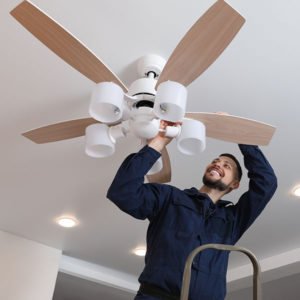Ideal Conditions: Common Ceiling Fan Questions and Answers
 At Ideal Conditions, we often receive questions about the proper installation and use of ceiling fans. We thought it would be beneficial to turn these common questions and answers into a robust ceiling fan FAQ that can help you! If you have any additional questions, contact our office at any time!
At Ideal Conditions, we often receive questions about the proper installation and use of ceiling fans. We thought it would be beneficial to turn these common questions and answers into a robust ceiling fan FAQ that can help you! If you have any additional questions, contact our office at any time!
How do I choose the right ceiling fan?
Although how a fan looks and how much it costs may be your number one concern, there are a variety of equally important factors to consider when choosing one, including energy efficiency, air circulation capabilities, and life span. Here are some key points to remember: wind speed, noise, durability, efficiency, and size.
Why does my ceiling fan make noise?
If your fan is humming, the cause is probably vibration in the motor. However, this can also be caused by loose screws or wiring issues, or your fan’s motor might need to be lubricated. In most cases, a simple hum won’t cause alarm and can be ignored. If you’ve noticed the noise getting louder, seek expert advice about repairing or replacing the unit.
Why does my ceiling fan wobble when it’s running?
The most common cause of a shaky fan is a loose connection between the unit and the ceiling, causing an uneven spin. Another common cause is uneven blades, causing unequal weight distribution. Uneven blades can damage your fan’s motor, leading to it wearing out sooner than it should. Blades can even be affected by the weight of a small dust buildup, so keep them clean.
My ceiling fan doesn’t work, but the light does. Why?
If your ceiling fan light still works but isn’t working, then your fan’s motor most likely has gone bad. You won’t want to undertake a project independently and should turn to a trained electrician to ensure your motor is replaced correctly.
Which way should a fan turn in winter and summer?
You’ll want to run your fan counterclockwise in the summer and clockwise in the winter for optimal temperatures in your home. A counterclockwise fan will generate a downdraft, keeping cool air down and warmer air from getting stagnant. On the other hand, a clockwise-spinning fan will pull air upward and keep your room at a comfortable temperature.
Can I use CFL or LED light bulbs in my fan?
Many ceiling fans come with compact fluorescents (CFL bulbs). However, if you purchase one that didn’t, you can use CFL bulbs in a standard ceiling fan light kit. Even better, however, is to choose a model that comes with LED Bulbs (light-emitting diodes), which are cost-effective, long-lasting, and environmentally friendly.
If you have more questions about your ceiling fan or other electric devices in your home, Ideal Conditions in Jacksonville, Florida, can answer them. If the answer to your question involves replacing a fan or installing a light kit, we can get that done for you. Call us at (904) 379-8762 or make an appointment online today.


